A chance encounter with a broken chair some 45 years ago led Jim Widess to a new career:
“I was teaching elementary school when I caned my first chair. Those nine hours afforded me the time to think about something other than usual daily concerns. It was a totally freeing experience…caning that first chair changed my life.”
In the absence of much literature or local teachers, (Jim remembers that he gained some first instruction from the old Whole Earth Catalog of the hippie ‘60’s). Jim taught himself to weave with cane, rush , wicker and splints, researched the history and art of caning at the Library of Congress, and then filled a void in “how to” books on caning by first co-authoring, and then solo writing and photographing demonstrated step-by-step instructions for the now classic works, The Caner’s Handbook (with Bruce W. Miller, Lark Books, 1991) & The Complete Guide to Chair Caning (Lark Books, 2005).
Jim took over The Caning Shop in Berkeley, California in 1969 where, in addition to repairing whatever damaged furniture walked in the door, he expanded his personal repertoire of weaving skills to basketry, and his carpentry skills to gourds as art & as musical instruments. Today, whatever space in The Caning Shop that isn’t filled with damaged chairs & tables waiting for a fix, is used to hold a complete line of fibers for caning, basketry, and gourd embellishment, as well as space for periodic classes in every kind of related of art or craft. (See, www.caning.com for Jim’s inventory). Meanwhile, Jim’s latest book, the beautifully photographed Gourds & Fiber, has just been released this year, his fourth gourd book to be co-authored with artist and ethnographer Ginger Summit.
A large space in Jim’s shop is devoted to the products of the rattan palm, the solid-stemmed seminal fiber that once spliced and shaped, is the most widely used material for caning today. Grown throughout tropical regions in Asia and West Africa, the quick-growing palms can reach 300 feet. Historically, only cuts from the shiny exterior peel were used for caning, but in the mid-19th century, U.S. factory processes for splitting the cane were developed that allowed for the production of the round and half-round reed used for much wicker caning and basketry today. Although caned chairs may be made of either pre-woven or hand-woven cane webbing, even the commercially-produced loomed webbing requires some hand weaving: the diagonal pieces that form the complex geometric patterns in most cane seats must be woven in by hand during the factory process.

caning sheet designs
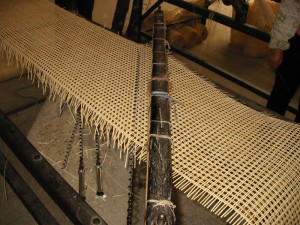
factory weaving with diagonal added
Hand caning can be remarkably complex with the execution of rare cane designs such as the “spider”, “snowflake” and “sunray” requiring years of expertise.
Decorative & structural rattan wraps used on both rattan and wicker furniture, can also employ beautifully complicated patterns and knots.However, most of Jim’s repair work is much more hum-drum, made simpler by tools that Jim has designed and now produces and sells. To maintain his artistic interest in caning, Jim is now working with a ceramicist, designing one-of-a kind teapot handles with a multitude of caning techniques.
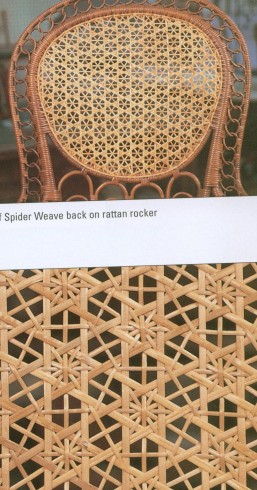
snowflake pattern
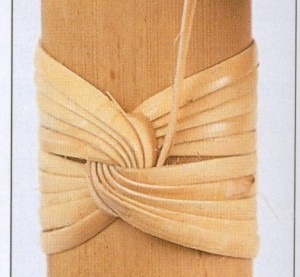
Wraps and knots
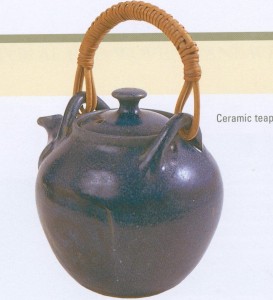
Teapot
Since much woven furniture does not use cane at all, Jim also weaves with other traditional and recent fibers. While rushes such as bulrush, cattail, and (here in California) tule have been used for seating for millennium, Jim is far more likely to use paper rush today. These processed fibers, such as Danish cord, are twisted into filaments to resemble natural rush and are wrapped and twined onto furniture frames; perhaps the most recognized furniture style to use such fibers today is Danish modern. Seagrass, a Chinese corded fiber, is similarly used. For classic Shaker furniture, Jim uses the heavy woven cotton strips known as Shaker tapes.
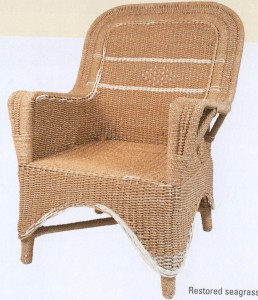
Seagrass chair
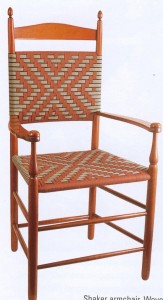
Shaker weave
The splint weaving techniques that Jim employs for chairs and footstools are familiar to most basketmakers, and frequently employ complex twill and herringbone designs. Oak, hickory, and ash splints are less commonly used today than rattan palm produced flat reed.
When Jim began his business 40 years ago, the comment he most often heard was, “You know how to repair my caned chair? I thought it was a lost art!” With his books, instruction and eagerness to spread his knowledge and love of weaving fibers, the question has become moot. If anything, Jim has inspired thousands of chair lovers across the country to gain the satisfaction of reweaving their chair seats as well as encouraging many even to consider becoming a professional and hanging out his or her own shingle.
—
Jim Widess
Your source for Caning, Basketry and Gourd Crafting Supplies
The Caning Shop
926 Gilman Street
Berkeley, CA 94710
1-800-544-3373
www.caning.com
Click here to see the next article